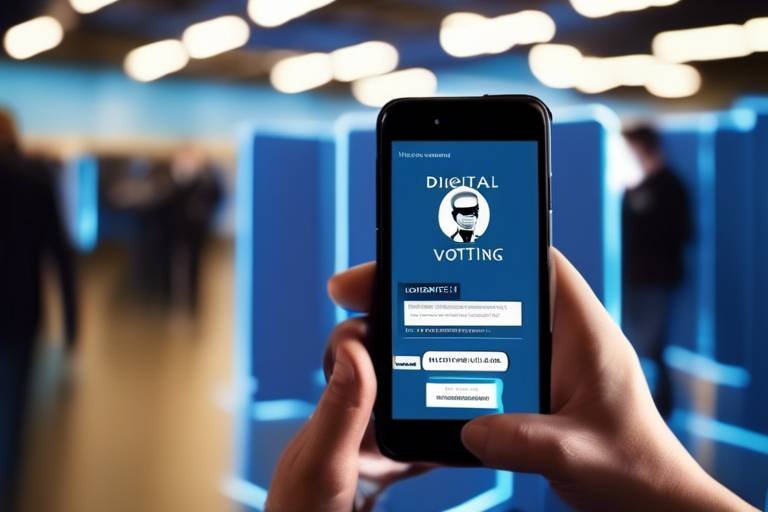How Blockchain is Changing the Game for Insurance Providers
In recent years, the insurance industry has been on the brink of a significant transformation, thanks to the emergence of blockchain technology. This revolutionary technology is not just a buzzword; it’s a game changer that’s reshaping how insurance providers operate. Imagine a world where claims are settled in seconds, fraud is nearly eradicated, and policyholders have complete visibility into their policies. Sounds too good to be true? Well, it’s becoming a reality, and in this article, we’ll explore how blockchain is leading this charge, enhancing transparency, efficiency, and customer trust.
To understand the impact of blockchain on insurance, we first need to grasp what blockchain is all about. At its core, blockchain is a decentralized digital ledger that records transactions across multiple computers. This means no single entity has control over the data, making it incredibly secure and resistant to tampering. In the insurance world, this decentralization can eliminate the need for intermediaries, streamline processes, and ultimately save time and money. But how exactly does this work in practice? Let’s dive deeper into the benefits of blockchain for insurance providers.
Understanding the fundamental principles of blockchain technology is crucial for insurance providers. This section delves into its decentralized nature, security features, and how it operates as a distributed ledger.
Blockchain offers numerous advantages for insurance providers, including enhanced transparency, reduced fraud, and streamlined claims processing. These benefits not only improve operational efficiency but also significantly enhance the customer experience.
One of the standout features of blockchain is its ability to provide real-time access to data. This transparency can revolutionize insurance practices by fostering trust between insurers and policyholders. Imagine being able to see the status of your claim in real time, with all the necessary data at your fingertips. This level of visibility minimizes disputes and enhances the overall customer experience. With blockchain, both parties can access the same information, ensuring everyone is on the same page and reducing the chances of miscommunication.
Another exciting aspect of blockchain is the implementation of smart contracts. These are self-executing contracts with the terms of the agreement directly written into code. They automate and enforce agreements without the need for intermediaries. In the context of insurance, this means claims can be processed automatically once certain conditions are met. For example, if a flight is delayed, the smart contract can automatically trigger a payout to the affected policyholder. This not only simplifies claims processing but also significantly reduces administrative costs for insurance providers.
Fraud is a significant issue in the insurance sector, costing billions of dollars each year. Blockchain’s immutable records are a powerful tool in the fight against fraud. Since all transactions are recorded on a public ledger that cannot be altered, it becomes much easier to detect and prevent fraudulent activities. Insurers can track claims and identify inconsistencies in real time, ultimately protecting both themselves and their customers. This capability can lead to lower premiums and increased trust in the insurance process.
Despite its advantages, the implementation of blockchain in insurance faces challenges. Regulatory compliance is a significant concern, as the technology is still relatively new and not fully understood by all stakeholders. Additionally, integrating blockchain with existing systems can be complex and costly. The need for industry-wide standards is also crucial; without a common framework, the full potential of blockchain cannot be realized.
Real-world applications of blockchain in the insurance industry provide valuable insights. Various global insurance companies are exploring blockchain solutions, showcasing notable initiatives and collaborations aimed at harnessing blockchain technology for improved service delivery. For instance, major insurers are working together to create shared blockchain platforms that enhance data sharing and reduce operational costs.
Several global insurance companies are leading the way in exploring blockchain solutions. These initiatives highlight the potential of blockchain to transform the industry. For example, a consortium of insurers is developing a blockchain-based platform to streamline the claims process, allowing for faster payouts and improved customer satisfaction.
Learning from early adopters can guide future implementations. Organizations that have successfully integrated blockchain into their operations have shared key takeaways and best practices. These insights can help others navigate the complexities of blockchain adoption and maximize its benefits.
The future of blockchain technology in insurance looks promising. As the industry continues to evolve, we can expect to see emerging trends and potential innovations that further enhance the capabilities of blockchain. With ongoing advancements, insurance providers that embrace this technology will likely gain a competitive edge, leading to a more efficient, transparent, and customer-centric industry.
- What is blockchain technology? - Blockchain is a decentralized digital ledger that records transactions across multiple computers, ensuring security and transparency.
- How does blockchain improve insurance? - It enhances transparency, reduces fraud, and streamlines claims processing, ultimately improving customer trust and satisfaction.
- What are smart contracts? - Smart contracts are self-executing contracts with terms directly written into code, automating agreements without intermediaries.
- What challenges does blockchain face in insurance? - Challenges include regulatory compliance, integration with existing systems, and the need for industry-wide standards.

The Basics of Blockchain Technology
Understanding the fundamental principles of blockchain technology is crucial for insurance providers looking to innovate and enhance their services. At its core, blockchain is a decentralized digital ledger that records transactions across multiple computers in a way that ensures the recorded information cannot be altered retroactively. This decentralized nature means that no single entity owns the entire database, which adds a layer of security and trust that traditional systems often lack.
One of the most fascinating aspects of blockchain is its security features. Each transaction is encrypted, and once it is recorded, it is linked to the previous transaction, forming a chain of blocks. This chain is maintained by a network of computers (or nodes) that validate and confirm each transaction through a consensus mechanism. This means that for a fraudulent transaction to occur, a hacker would need to alter every single block in the chain across all nodes, making it virtually impossible.
To illustrate how blockchain operates, consider the following points:
- Distributed Ledger: Every participant in the network has access to the same version of the ledger, ensuring transparency.
- Consensus Mechanisms: Transactions are verified through methods like Proof of Work or Proof of Stake, ensuring that all parties agree on the validity of transactions.
- Immutability: Once a transaction is recorded, it cannot be changed or deleted, providing an accurate historical record.
These features make blockchain particularly appealing for the insurance industry, where trust, transparency, and security are paramount. By leveraging blockchain, insurance providers can create a more efficient system that not only minimizes the risk of fraud but also enhances the overall customer experience. Imagine a world where claims are processed almost instantly, and policyholders can track the status of their claims in real-time. That’s the promise of blockchain technology.
However, it's essential to note that while blockchain offers incredible potential, it also presents challenges. As insurance providers explore integrating this technology, they must navigate issues such as regulatory compliance, data privacy, and the need for industry-wide standards. Understanding these basics will prepare insurers to harness the full power of blockchain and transform their operations for the better.

Benefits of Blockchain for Insurance
Blockchain technology is not just a buzzword; it's a game-changer for the insurance industry. Imagine a world where transactions are not only faster but also more secure and transparent. That's what blockchain brings to the table. By leveraging its decentralized nature, insurance providers can significantly enhance their operations. With blockchain, data is stored in a way that is immutable and accessible to all authorized parties, creating a level of trust that has been hard to achieve in traditional systems.
One of the most significant benefits of blockchain for insurance is enhanced transparency. In an industry often marred by disputes and misunderstandings, having real-time access to data can be revolutionary. For instance, both insurers and policyholders can view the same information regarding claims and policy details, which minimizes the chances of disputes. This transparency fosters a relationship built on trust. When customers feel that they are being treated fairly and that their claims are processed efficiently, their loyalty to the insurer increases. It's like having a glass wall instead of a brick wall between the insurer and the insured.
Moreover, blockchain technology facilitates the use of smart contracts. These are self-executing contracts with the terms of the agreement directly written into code. For insurance providers, this means that claims can be processed automatically based on predefined conditions. Imagine a scenario where a policyholder files a claim for a car accident. Instead of waiting days or weeks for a claims adjuster to review the case, a smart contract can automatically verify the claim against the conditions set in the policy and release payment instantly. This not only speeds up the claims process but also reduces administrative costs, allowing insurers to allocate resources more efficiently.
Another critical advantage is the reduction of fraud. Fraudulent activities cost the insurance industry billions of dollars each year. Blockchain's immutable ledger means that once a transaction is recorded, it cannot be altered or deleted. This feature makes it incredibly challenging for fraudsters to manipulate data. For example, if a claim is made, the blockchain can provide a complete history of the policy and any previous claims, making it easier to identify suspicious activities. With this level of security, both insurers and customers can feel more protected.
To summarize, the benefits of blockchain for insurance providers are vast and impactful:
- Enhanced Transparency: Real-time data access promotes trust and reduces disputes.
- Smart Contracts: Automated claims processing saves time and reduces costs.
- Fraud Reduction: Immutable records help detect and prevent fraudulent activities.
As the insurance industry continues to evolve, embracing blockchain technology can lead to a more efficient, transparent, and secure environment for all stakeholders involved. The potential for increased customer satisfaction and operational efficiency is immense, making it a compelling option for insurance providers looking to stay ahead in a competitive market.
Q1: How does blockchain improve transparency in insurance?
A1: Blockchain allows all parties involved in a transaction to have real-time access to the same data, minimizing the chances of disputes and fostering trust.
Q2: What are smart contracts, and how do they work in insurance?
A2: Smart contracts are self-executing agreements where the terms are written into code. They automate processes like claims handling, enabling faster and more efficient transactions.
Q3: Can blockchain really help reduce insurance fraud?
A3: Yes, the immutable nature of blockchain records makes it difficult for fraudsters to alter data, allowing for better detection and prevention of fraudulent claims.

Enhanced Transparency
Transparency is more than just a buzzword in the insurance industry; it’s a fundamental pillar that can reshape the relationship between insurers and policyholders. With the advent of blockchain technology, the concept of transparency is being taken to a whole new level. Imagine a world where every transaction is recorded in real time, accessible to all parties involved, and immutable. This is the promise of blockchain, and it can significantly enhance trust in the insurance sector.
At its core, blockchain operates as a distributed ledger, meaning that all transactions are recorded across multiple nodes in the network. This decentralization not only makes it nearly impossible to alter or delete records, but it also ensures that all stakeholders have access to the same information. When policyholders can see the same data as insurers, it minimizes misunderstandings and disputes. Think of it like having a shared notebook where both parties can see every entry made—there's no room for secrets or hidden agendas.
The impact of enhanced transparency can be profound. For instance, when a claim is filed, both the insurer and the policyholder can track its status through the blockchain. This real-time access can lead to quicker resolutions and a more satisfactory experience for customers. Instead of waiting for updates or feeling in the dark, policyholders can see exactly where their claim stands. This level of transparency fosters a culture of accountability and trust, which is often lacking in traditional insurance models.
Furthermore, the ability to access historical data through blockchain can help in understanding trends and patterns, leading to better risk assessment and pricing strategies. Insurers can analyze data more effectively, allowing them to create more personalized policies that meet the unique needs of individuals.
In addition to improving the relationship between insurers and policyholders, enhanced transparency can also benefit regulatory bodies. With clear, immutable records, regulators can more easily monitor compliance and detect irregularities. This not only protects consumers but also helps maintain the integrity of the insurance market as a whole.
To illustrate the impact of enhanced transparency, consider the following table that summarizes how blockchain technology can improve various aspects of the insurance process:
| Aspect | Traditional Insurance | Blockchain-Enabled Insurance |
|---|---|---|
| Data Access | Limited access for policyholders | Real-time access for all parties |
| Claim Processing | Lengthy and opaque | Quick and transparent |
| Fraud Detection | Reactive measures | Proactive prevention through immutable records |
| Regulatory Compliance | Challenging to monitor | Easy to audit and verify |
In conclusion, the enhanced transparency offered by blockchain technology is not just a benefit; it's a game-changer. By fostering trust, reducing disputes, and streamlining processes, blockchain has the potential to redefine the insurance landscape. As we move forward, it’s clear that embracing this technology will be essential for insurance providers looking to thrive in an increasingly competitive market.

Smart Contracts in Insurance
Smart contracts are revolutionizing the insurance industry by automating and enforcing agreements without the need for intermediaries. Imagine a world where your insurance claims are processed in a matter of minutes rather than days or weeks. This is not just a dream; it’s becoming a reality thanks to blockchain technology. So, what exactly are smart contracts, and how do they work in the context of insurance?
At its core, a smart contract is a self-executing contract with the terms of the agreement directly written into code. This code lives on the blockchain, which means it's immutable and transparent. When certain pre-defined conditions are met, the smart contract automatically executes the agreed-upon actions. For instance, if a policyholder submits a claim for a car accident, the smart contract can instantly verify the claim against the data stored on the blockchain, such as accident reports, witness statements, and even traffic camera footage. Once verified, the payment can be processed immediately without human intervention.
Here are some of the key benefits of using smart contracts in the insurance sector:
- Speed: Claims processing can be significantly faster, reducing the time policyholders have to wait for payouts.
- Cost-Effectiveness: By eliminating intermediaries, administrative costs are lowered, allowing insurers to allocate resources more efficiently.
- Accuracy: Automated processes reduce the risk of human error, ensuring that claims are handled correctly and fairly.
- Trust: The transparency of smart contracts fosters trust between insurers and policyholders, as both parties can see the same data and understand how decisions are made.
Moreover, smart contracts can also facilitate more complex insurance products. For instance, in the case of travel insurance, a smart contract could automatically trigger a payout if a flight is delayed or canceled. This level of automation not only enhances customer satisfaction but also promotes a more dynamic insurance model that can adapt to real-time data.
However, it's essential to understand that the implementation of smart contracts is not without its challenges. Insurers must ensure that the data feeding into these contracts is accurate and trustworthy. Additionally, regulatory frameworks need to evolve to accommodate this technology. As the industry continues to explore the potential of smart contracts, it’s clear that they hold the promise of transforming the way insurance providers operate.
In conclusion, smart contracts represent a significant leap forward for the insurance industry. They offer a glimpse into a future where transactions are seamless, efficient, and transparent. As more insurance companies begin to embrace this technology, we can expect a shift in how policies are managed and claims are processed, ultimately leading to a better experience for consumers.
Q1: What are smart contracts?
A1: Smart contracts are self-executing contracts with the terms of the agreement directly written into code, stored on a blockchain. They automatically execute actions when pre-defined conditions are met.
Q2: How do smart contracts benefit insurance providers?
A2: They enhance speed and efficiency in claims processing, reduce administrative costs, minimize human errors, and foster trust through transparency.
Q3: Are there any challenges in implementing smart contracts?
A3: Yes, challenges include ensuring data accuracy, adapting regulatory frameworks, and integrating with existing systems.
Q4: Can smart contracts be used for all types of insurance?
A4: While they can be applied to many types of insurance, their effectiveness may vary depending on the complexity and nature of the insurance product.

Fraud Reduction
Fraud is a significant concern in the insurance industry, costing billions of dollars each year. It's like a shadow lurking behind every claim, ready to pounce and take advantage of unsuspecting insurers and policyholders alike. However, the advent of blockchain technology is turning the tide against this pervasive issue. With its immutable records and decentralized nature, blockchain offers a robust solution to detect and prevent fraudulent activities.
At its core, blockchain is a distributed ledger that ensures every transaction is recorded in a way that cannot be altered or deleted. This feature is crucial in the insurance sector, where the authenticity of claims is paramount. Imagine a world where every policyholder’s history is securely stored and easily accessible, allowing insurers to verify claims against a comprehensive database. This level of transparency can significantly reduce instances of fraud, as it becomes increasingly difficult for dishonest actors to manipulate or falsify information.
Moreover, the use of smart contracts further enhances the fraud prevention capabilities of blockchain. These self-executing contracts automatically enforce the terms of an agreement, ensuring that claims are only processed when certain conditions are met. For instance, if a policyholder claims damages, the smart contract can automatically verify the event through external data sources, such as weather reports or police records, before releasing any funds. This not only streamlines the claims process but also acts as a deterrent against fraudulent claims.
To illustrate the impact of blockchain on fraud reduction, consider the following table that outlines traditional fraud detection methods versus blockchain-enabled solutions:
| Traditional Methods | Blockchain Solutions |
|---|---|
| Manual verification processes | Automated verification through smart contracts |
| Centralized databases prone to hacking | Decentralized ledger that is secure and tamper-proof |
| Delayed claims processing due to investigations | Real-time access to verified information |
| High operational costs for fraud detection | Reduced costs through streamlined processes |
In addition, blockchain technology fosters collaboration among insurers. By sharing data across a secure network, companies can collectively identify patterns of fraud that may not be visible when operating in isolation. This collaborative approach not only enhances the detection of fraudulent activities but also strengthens the overall integrity of the insurance ecosystem.
In conclusion, the implementation of blockchain technology in the insurance industry holds immense potential for reducing fraud. By leveraging its unique features, insurers can create a more transparent, efficient, and trustworthy environment for policyholders. The future of insurance could very well be a landscape where fraud is minimized, and genuine claims are processed swiftly and fairly, restoring confidence in the industry.
- What is blockchain technology? Blockchain is a decentralized digital ledger that records transactions across many computers in a way that ensures the recorded information cannot be altered retroactively.
- How does blockchain reduce fraud in insurance? Blockchain reduces fraud by providing immutable records of transactions, enabling real-time verification of claims, and automating processes through smart contracts.
- Are there any challenges to implementing blockchain in insurance? Yes, challenges include regulatory compliance, integration with existing systems, and the need for industry-wide standards.
- What are smart contracts? Smart contracts are self-executing contracts with the terms of the agreement directly written into code, allowing for automatic enforcement and execution of terms.
- Can blockchain enhance customer trust in insurance? Absolutely! By increasing transparency and reducing fraud, blockchain can significantly enhance trust between insurers and policyholders.

Challenges of Implementing Blockchain
While the potential of blockchain technology in the insurance sector is immense, the journey toward its implementation is not without hurdles. One of the primary challenges is regulatory compliance. Insurance is a heavily regulated industry, and integrating blockchain solutions requires navigating a complex landscape of laws and regulations that vary by region. Companies must ensure that their blockchain systems comply with existing regulations while also anticipating changes that may arise as this technology evolves.
Another significant challenge is integration with existing systems. Many insurance providers still rely on legacy systems that may not be compatible with blockchain technology. Transitioning to a new system can be a daunting task, often requiring substantial investment in both time and resources. This integration process can also lead to operational disruptions, which can be detrimental to customer service and overall business efficiency.
Additionally, there is a pressing need for industry-wide standards. Currently, various blockchain platforms exist, each with its own protocols and functionalities. Without a common set of standards, interoperability between different systems becomes a significant barrier. This lack of uniformity can lead to fragmentation within the industry, making it difficult for insurance providers to collaborate effectively and share data securely.
Moreover, there are concerns surrounding data privacy and security. While blockchain is often touted for its security features, the very nature of a public ledger can raise questions about how sensitive customer information is stored and accessed. Insurance companies must strike a balance between transparency and protecting their clients’ personal data, ensuring that their blockchain solutions do not inadvertently expose sensitive information.
Finally, the educational gap within the industry cannot be overlooked. Many professionals in the insurance sector may lack a deep understanding of blockchain technology, which can hinder its adoption. Training and education are essential to equip staff with the knowledge needed to leverage blockchain effectively. This gap can lead to resistance to change, as employees may be hesitant to adopt new technologies that they do not fully understand.
In summary, while blockchain holds transformative potential for the insurance industry, addressing these challenges is crucial for successful implementation. By focusing on regulatory compliance, integration with existing systems, establishing industry standards, ensuring data privacy, and closing the educational gap, insurance providers can pave the way for a more efficient and transparent future.
- What is blockchain technology? Blockchain is a decentralized digital ledger that records transactions across multiple computers securely and transparently.
- How can blockchain reduce fraud in insurance? Blockchain's immutable records make it difficult to alter data, thereby reducing the chances of fraudulent claims.
- What are smart contracts? Smart contracts are self-executing contracts with the terms of the agreement directly written into code, allowing for automatic enforcement and processing.
- What challenges do insurance companies face when implementing blockchain? Key challenges include regulatory compliance, integration with legacy systems, the need for industry standards, data privacy concerns, and a lack of understanding of the technology.
- Is blockchain technology secure? Yes, blockchain is considered secure due to its decentralized nature and cryptographic techniques, but it is essential to implement proper safeguards to protect sensitive information.

Case Studies of Blockchain in Insurance
The insurance industry is experiencing a significant transformation thanks to blockchain technology. To understand its impact more clearly, let's dive into some compelling case studies that illustrate how leading insurance companies are harnessing this innovative technology. These real-world examples not only highlight the practical applications of blockchain but also showcase the tangible benefits it brings to the table.
One notable case is that of AXA, a global insurance giant that has implemented blockchain for flight delay insurance. Their product, called Fizzy, utilizes smart contracts to automatically trigger payouts to policyholders when a flight is delayed by over two hours. This eliminates the need for tedious claims processes and enhances customer satisfaction. The use of blockchain ensures that all transactions are recorded securely and transparently, providing both the insurer and the insured with peace of mind.
Another impressive example comes from MetLife, which launched a similar initiative called Vitana. This product is designed for new parents and offers a payout upon the birth of a child. The entire process is automated through blockchain, which significantly reduces administrative burdens and speeds up the claims process. By leveraging this technology, MetLife not only improves operational efficiency but also builds stronger relationships with its customers by delivering prompt and reliable service.
In addition to these individual initiatives, there are collaborative efforts within the industry. The Insurance Blockchain Initiative, which includes major players like IBM and Accenture, aims to create a shared blockchain platform for the insurance sector. This initiative focuses on enhancing data sharing, improving risk assessment, and minimizing fraud. By working together, these companies are paving the way for a more efficient and transparent insurance ecosystem.
To further illustrate the impact of blockchain, let's take a look at a table summarizing some of the key case studies mentioned above:
| Company | Product | Key Features | Benefits |
|---|---|---|---|
| AXA | Fizzy | Flight delay insurance, Smart contracts | Automated payouts, Enhanced customer satisfaction |
| MetLife | Vitana | Payout upon birth, Automated process | Reduced admin burden, Faster claims |
| Insurance Blockchain Initiative | N/A | Shared blockchain platform | Improved data sharing, Minimized fraud |
These case studies demonstrate that the integration of blockchain technology in insurance is not just a theoretical concept; it's a practical reality that many companies are embracing. By adopting blockchain, insurers can enhance operational efficiency, reduce costs, and ultimately provide better service to their customers. The journey of blockchain in insurance is just beginning, and as more companies explore its potential, we can expect to see even more innovative applications emerge.
Q: What is blockchain technology?
A: Blockchain is a decentralized digital ledger that securely records transactions across multiple computers. It ensures that the data is immutable and transparent, making it ideal for industries like insurance.
Q: How does blockchain improve insurance claims processing?
A: Blockchain automates claims processing through smart contracts, which execute automatically when predefined conditions are met. This reduces the time and effort needed for claims approval.
Q: Are there any challenges in implementing blockchain in insurance?
A: Yes, challenges include regulatory compliance, integration with existing systems, and the need for industry-wide standards to ensure interoperability.
Q: What are some examples of blockchain use in insurance?
A: Examples include AXA's Fizzy for flight delays and MetLife's Vitana for childbirth payouts, both utilizing smart contracts for automated claims.
Q: What does the future hold for blockchain in insurance?
A: The future looks promising, with potential innovations in risk assessment, customer engagement, and fraud prevention as the technology continues to evolve.

Global Insurance Initiatives
The insurance industry is undergoing a significant transformation, and one of the most exciting aspects of this evolution is the global exploration of blockchain technology. Major insurance companies around the world are not just dipping their toes into blockchain; they are diving headfirst into innovative projects that promise to reshape the landscape of insurance. By leveraging this cutting-edge technology, these organizations aim to enhance efficiency, improve customer experiences, and build a stronger foundation of trust within the industry.
For instance, a consortium of insurers in Europe has come together to develop a blockchain-based platform that allows for real-time data sharing among various stakeholders. This initiative is designed to streamline processes such as underwriting and claims management, making them faster and more transparent. Imagine a world where claims are processed almost instantaneously, with all parties having access to the same verified information. This is not just a dream; it’s becoming a reality thanks to blockchain.
Across the Atlantic, several U.S. insurance companies are also exploring blockchain solutions. One notable initiative involves the use of smart contracts to automate policy issuance and claims settlements. These smart contracts can execute transactions automatically when certain conditions are met, drastically reducing the need for manual intervention. This not only speeds up the process but also minimizes errors that can lead to disputes.
In Asia, nations like Singapore and Japan are at the forefront of blockchain innovation in insurance. The Monetary Authority of Singapore has been actively promoting blockchain technology as part of its Smart Nation initiative. Insurers in Singapore are experimenting with blockchain to enhance customer onboarding processes and reduce fraud through improved identity verification methods. The potential for blockchain to create a secure and efficient ecosystem is being recognized globally, and the results are promising.
To illustrate the impact of these initiatives, here’s a brief overview of some key projects:
| Region | Initiative | Description |
|---|---|---|
| Europe | Data Sharing Consortium | Real-time data sharing platform for underwriting and claims management. |
| USA | Smart Contracts | Automating policy issuance and claims settlements. |
| Asia | Smart Nation Initiative | Enhancing customer onboarding and fraud reduction through blockchain. |
These examples highlight the collaborative spirit within the insurance sector as companies recognize the value of sharing knowledge and resources. By working together, insurers can create a more robust framework for blockchain implementation, ultimately benefiting consumers and the industry as a whole. The global initiatives not only showcase the versatility of blockchain but also emphasize the importance of adapting to technological advancements to stay competitive in an ever-evolving market.
As these initiatives continue to evolve, they will undoubtedly provide valuable lessons and insights that can guide future blockchain implementations. The insurance industry is on the brink of a major shift, and those who embrace these changes will be well-positioned to thrive in the new digital economy.
- What is blockchain technology? Blockchain is a decentralized digital ledger that records transactions across many computers securely and transparently.
- How can blockchain improve insurance? It enhances transparency, reduces fraud, and streamlines claims processing through real-time data access and automation.
- Are there any challenges in implementing blockchain in insurance? Yes, challenges include regulatory compliance, integration with existing systems, and the need for industry-wide standards.
- What are smart contracts? Smart contracts are self-executing contracts with the terms of the agreement directly written into code, automating processes without intermediaries.

Lessons Learned from Early Adopters
As the insurance industry begins to embrace blockchain technology, the experiences of early adopters serve as invaluable lessons for others looking to navigate this uncharted territory. These pioneers have uncovered a wealth of insights that can shape the future of insurance, ensuring smoother transitions and more effective implementations. One of the primary lessons learned is the importance of collaboration. Early adopters discovered that working closely with technology providers, regulators, and even competitors can lead to shared success. By pooling resources and knowledge, these companies have been able to overcome common challenges and create robust blockchain solutions.
Another critical takeaway is the need for comprehensive training and education within organizations. Many early adopters found that simply implementing blockchain technology was not enough. They needed to invest in training their teams to understand how blockchain works, its benefits, and how to leverage it effectively. This investment in human capital has proven essential in maximizing the technology's potential, as employees who are well-versed in blockchain can identify opportunities and troubleshoot issues that may arise.
Moreover, early adopters have emphasized the significance of starting small. Rather than attempting to overhaul their entire operations at once, many companies have opted to implement blockchain solutions in phased approaches. This strategy allows them to test the waters, learn from initial implementations, and gradually scale their efforts based on real-world feedback. For instance, a pilot program focusing on a specific area, such as claims processing, can provide insights that inform broader applications down the line.
In addition, early adopters have recognized the value of customer engagement. By involving policyholders in the development and implementation process, these companies have been able to tailor their blockchain solutions to better meet customer needs. Engaging customers not only fosters trust but also encourages feedback that can lead to further improvements. This customer-centric approach has been crucial in ensuring that the technology enhances the overall user experience.
Finally, the importance of regulatory awareness cannot be overstated. Early adopters have learned that navigating the regulatory landscape is a vital part of implementing blockchain in insurance. By staying informed about regulations and actively participating in discussions with regulators, these companies can ensure compliance while also advocating for standards that support innovation in the industry.
To summarize, the lessons learned from early adopters of blockchain in the insurance sector highlight the need for collaboration, education, phased implementation, customer engagement, and regulatory awareness. By embracing these principles, future adopters can position themselves for success in leveraging blockchain technology to transform their operations and enhance customer trust.
- What is blockchain technology? Blockchain is a decentralized digital ledger that records transactions across multiple computers, ensuring that the data cannot be altered retroactively.
- How does blockchain enhance transparency in insurance? Blockchain allows real-time access to data for all stakeholders, reducing disputes and fostering trust between insurers and policyholders.
- What are smart contracts? Smart contracts are self-executing contracts with the terms of the agreement directly written into code, automating processes and reducing the need for intermediaries.
- What challenges do insurers face when implementing blockchain? Challenges include regulatory compliance, integration with existing systems, and the need for industry-wide standards.
- What can we expect in the future of blockchain in insurance? The future looks promising, with potential innovations and emerging trends aimed at enhancing efficiency and customer experience.

The Future of Blockchain in Insurance
The future of blockchain technology in the insurance industry is not just a fleeting trend; it represents a seismic shift that could redefine how insurers operate and interact with their clients. As we look forward, it's clear that the integration of blockchain will lead to a more efficient, transparent, and secure insurance landscape. Imagine a world where claims are processed in real-time, disputes are minimized, and trust is built into every transaction. This is the promise that blockchain holds for the insurance sector.
One of the most exciting prospects is the potential for decentralized insurance models. These models allow for peer-to-peer insurance, where individuals can pool their resources to cover risks collectively, without the need for traditional insurance companies. This could significantly lower costs and increase accessibility for consumers. By utilizing smart contracts, these models can automate claims processing, ensuring that payouts are made almost instantaneously when predefined conditions are met. This kind of efficiency is a game-changer!
Moreover, as artificial intelligence (AI) and machine learning technologies continue to evolve, their integration with blockchain will usher in a new era of predictive analytics in insurance. Insurers will be able to analyze vast amounts of data securely and efficiently, leading to better risk assessment and personalized insurance products. For instance, a health insurance provider could use blockchain to securely access a patient's medical history, while AI algorithms analyze this data to offer customized plans that reflect the individual's specific needs.
However, the road ahead is not without its challenges. As blockchain technology evolves, so too must the regulatory frameworks that govern it. Insurance providers will need to work closely with regulators to ensure compliance while still fostering innovation. The establishment of industry-wide standards will be crucial in facilitating the seamless integration of blockchain across different platforms and systems. This collaborative approach will not only promote trust among stakeholders but also enhance the overall effectiveness of blockchain applications in insurance.
In addition to regulatory hurdles, there is also the challenge of educating both insurers and consumers about the benefits and functionalities of blockchain. A well-informed customer base is essential for the widespread adoption of any new technology. Therefore, insurers will need to invest in educational initiatives that demystify blockchain and showcase its advantages, such as enhanced security and efficiency.
As we peer into the future, it's evident that blockchain technology will not simply augment existing processes; it will fundamentally transform the insurance industry. The potential for increased customer trust cannot be overstated. When clients know that their data is secure and that claims are handled transparently, they are more likely to engage with insurers and remain loyal. This shift towards a more customer-centric model will ultimately drive growth and innovation in the sector.
In conclusion, the future of blockchain in insurance is bright and full of possibilities. With ongoing advancements and a commitment to collaboration, the insurance industry can harness the full potential of this transformative technology. The journey may be challenging, but the rewards—enhanced efficiency, reduced fraud, and improved customer satisfaction—are well worth the effort.
- What is blockchain technology?
Blockchain is a decentralized digital ledger that records transactions across many computers securely and immutably. - How does blockchain improve insurance?
It enhances transparency, reduces fraud, and streamlines claims processing, leading to improved customer trust and operational efficiency. - What are smart contracts?
Smart contracts are self-executing contracts with the terms of the agreement directly written into code, allowing for automatic enforcement without intermediaries. - What challenges does blockchain face in insurance?
Challenges include regulatory compliance, integration with existing systems, and the need for industry-wide standards. - What is the future of blockchain in insurance?
The future looks promising, with potential for decentralized insurance models, AI integration, and increased customer trust.
Frequently Asked Questions
-
What is blockchain technology?
Blockchain technology is a decentralized digital ledger that records transactions across multiple computers. This ensures that the recorded transactions cannot be altered retroactively, providing a high level of security and transparency. Each block in the chain contains a number of transactions, and once a block is filled, it is added to the chain in a linear, chronological order.
-
How does blockchain enhance transparency in insurance?
Blockchain enhances transparency by allowing all parties involved in an insurance contract to access the same information in real-time. This means that insurers and policyholders can view the same data, reducing misunderstandings and disputes. It creates a trust-based environment where both parties can verify the authenticity of the information without relying on intermediaries.
-
What are smart contracts and how do they work in insurance?
Smart contracts are self-executing contracts with the terms of the agreement directly written into code. In insurance, they automate the claims process by triggering payments when certain conditions are met, such as a verified incident. This not only speeds up the claims process but also reduces administrative costs, making the entire experience smoother for both insurers and policyholders.
-
Can blockchain help reduce fraud in the insurance industry?
Absolutely! Blockchain's immutable records make it extremely difficult for fraudulent activities to go unnoticed. Every transaction is recorded and time-stamped, creating a transparent trail that can be audited. This level of scrutiny helps insurers identify suspicious patterns and prevent fraudulent claims, ultimately safeguarding both the companies and their customers.
-
What challenges does the insurance industry face when implementing blockchain?
While blockchain offers numerous benefits, the insurance industry faces challenges such as regulatory compliance, integration with existing systems, and the need for industry-wide standards. These hurdles can slow down the adoption of blockchain technology, as companies must navigate the complexities of aligning new technologies with established regulations and practices.
-
Are there any real-world examples of blockchain in insurance?
Yes, several global insurance companies are actively exploring blockchain solutions. For example, some firms have launched pilot projects to streamline claims processing or enhance policyholder verification. These case studies provide valuable insights into the practical applications of blockchain and its potential to transform the insurance landscape.
-
What does the future hold for blockchain in the insurance sector?
The future of blockchain in insurance looks bright! As technology continues to evolve, we can expect to see more innovative applications that enhance efficiency, improve customer experience, and foster greater trust. Emerging trends might include the use of artificial intelligence in conjunction with blockchain to further streamline processes and enhance risk assessment.



















